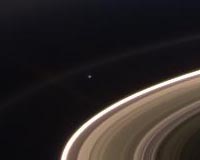 |
Pasadena CA (SPX) Sep 15, 2009 Scientist using the Cassini spacecraft's Magnetospheric Imaging instrument (MIMI) have detected a new, temporary radiation belt at Saturn, located around the orbit of its moon Dione at about 377,000 km from the centre of the planet. The discovery will be presented at the European Planetary Science Congress in Potsdam by Dr. Elias Roussos on Monday 14 September. Radiation belts, like Earth's Van Allen belts, have been discovered at Jupiter, Saturn, Uranus and Neptune. However, to date, it has only been possible to observe the variability of their intensity at Earth and Jupiter. Now that Cassini has been orbiting Saturn for more than five years, it has been possible to assess for the first time changes in Saturn's radiation belts. An international team of astronomers made the discovery analyzing data from the MIMI's LEMMS sensor, which measures the energy and angular distribution of charged particles in the magnetic bubble that surrounds Saturn. "The most dramatic changes have been observed as sudden increases in the intensity of high energy charged particles in the inner part of Saturn's magnetosphere, in the vicinity of the moons Dione and Tethys", said Dr. Roussos. "These intensifications, which could create temporary satellite atmospheres around these moons, occurred three times in 2005 as a response to an equal number of solar storms that hit Saturn's magnetosphere and formed a new, temporary component to Saturn's radiation belts", he added. The new belt, which has been named "the Dione belt", was only detected by MIMI/LEMMS for a few weeks after each of its three appearances. The team believe that newly formed charged particles in the Dione belt were gradually absorbed by Dione itself and another nearby moon, named Tethys, which lies slightly closer to Saturn at an orbit of 295,000 km. Unlike the Van Allen belts around the Earth, Saturn's radiation belts inside the orbit of Tethys are very stable, showing negligible response to solar storm occurrences and no variability over the five years that they have been monitored by Cassini. Interestingly, it was found that the transient Dione belt was only detected outside the orbit of Tethys. It appeared to be clearly separated from the inner belts by a permanent radiation gap all along the orbit of Tethys. "Our observations suggest that Tethys acts as a barrier against inward transport of energetic particles and is shielding the planet's inner radiation belts from solar wind influences. That makes the inner, ionic radiation belts of Saturn the most isolated magnetospheric structure in our solar system", said Dr. Roussos. The radiation belts within Tethys's orbit probably arise from the interaction of the planet's main rings and atmosphere and galactic cosmic ray particles that, unlike the solar wind, have the very high energies needed to penetrate the innermost Saturnian magnetosphere. This means that the inner radiation belts will only vary if the cosmic ray intensities at the distance of Saturn change significantly. However, Dr. Roussos emphasized, "Outside the orbit of Tethys, the variability of Saturn's radiation belt might be enhanced in the coming years as we start approaching the solar maximum. If solar storms occur frequently in the new solar cycle, the Dione belt might become a permanent, although highly variable, component of Saturn's magnetosphere, which could affect significantly Saturn's global magnetospheric dynamics." Share This Article With Planet Earth
Related Links Cassini Equinox Mission Explore The Ring World of Saturn and her moons Jupiter and its Moons The million outer planets of a star called Sol News Flash at Mercury
 Cassini Marks 10 Years Off Earth
Cassini Marks 10 Years Off EarthPasadena CA (JPL) Aug 20, 2009 A decade ago, NASA's Cassini spacecraft flew past Earth at a distance of 1,171 kilometers (727 miles) on its way to an appointment with the solar system's second largest occupant - Saturn. Launched in October of 1997, Cassini required a grand total of four planetary flybys to provide the gravity boost it needed to get to the ringed world. A gravity boost uses a planet's mass and orbi ... read more |
|
| The content herein, unless otherwise known to be public domain, are Copyright 1995-2009 - SpaceDaily. AFP and UPI Wire Stories are copyright Agence France-Presse and United Press International. ESA Portal Reports are copyright European Space Agency. All NASA sourced material is public domain. Additional copyrights may apply in whole or part to other bona fide parties. Advertising does not imply endorsement,agreement or approval of any opinions, statements or information provided by SpaceDaily on any Web page published or hosted by SpaceDaily. Privacy Statement |